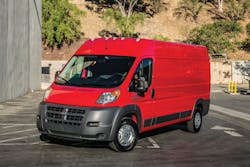Nissan Commercial Vehicles
For 2014, the Nissan NV Cargo van again provides exceptional utility – thanks to a long, wide cargo floor, square-top wheelwell housings and nearly vertical sidewalls. Along with maximizing cargo space, the sidewalls accommodate aftermarket storage systems without excessive modification. It is offered in three innovative versions – NV1500, NV2500 HD and NV3500 HD – and in two roof configurations – Standard Roof and High Roof.
Enhancements for 2014 include:
- Revised content between S and SV grades
- Tow Mode A/T, Class-IV receiver hitch, 7-pin connector pre-wiring, brake controller pre-wiring and heavy duty battery now standard on all V8 engine-equipped models
In addition, Nissan’s- NV200 Compact Cargo van – the "next innovation for business" provides large cargo capacity with a small exterior footprint. Launched in the U.S. in spring 2013, it offers an efficient 2.0-liter 16-valve 4-cylinder engine, next-gen gen Xtronic CVT, roomy cargo area (allows for loading standard U.S. 40x48-inch pallets) and 1,500-pound maximum payload. It is offered in S and SV models.
2014 Ford Transit, Transit Connect
Ford’s all-new full-size 2014 Transit van will provide unmatched fuel economy, innovative new configurations and leading versatility in the expanding commercial vehicle market.
The 2014 Ford Transit is available in three body lengths; two wheelbases; three roof heights; and in van, wagon, chassis cab and cutaway variations
Ford Transit will achieve an average of 25 percent better fuel economy and haul at least 300 pounds more than today’s E-Series
For North America, Transit will eventually replace the E-Series nameplate, first sold in 1961 as Ford Econoline and America’s best-selling commercial van for 33 years. In other global markets, this all-new vehicle will replace popular, market-specific Transit models first sold in 1965, and the best-selling commercial van in Europe.
Transit also is joined by the upgraded 2014 Ford Transit Connect, which pioneered the small van market in the United States and has been a hit with cost-conscious commercial fleets and small business proprietors.
Transit will be offered in three body lengths; two wheelbases; three roof heights; van, wagon, chassis cab and cutaway bodystyles; and in XL and XLT trim levels.
The high-roof Transit features 81 inches of interior cargo height, enough headroom for a person standing six foot, five inches tall to stand upright in the cargo area. The medium roof can accommodate up to 72 inches of cargo height and the low roof has 56 inches of cargo height to provide an ideal combination of payload management, upfit readiness and garageability. Cargo volume ranges from 256 cubic feet to more than 550 cubic feet – nearly 75 percent more space than a Chevrolet Express.
Transit’s rear cargo doors open 270 degrees for easy rear cargo space access.
The interior of each Transit van features advanced, durable LED lighting and has been developed for easy upfit of racks, bins, shelving and other cargo storage and hauling solutions. The largest passenger version can carry up to 15 people.
Redesigned from the ground up, the 2014 Ford Transit Connect drives and parks like a car, hauls more payload than a full-size Ram 1500 pickup and delivers fuel efficiency unmatched by any other commercial vehicle in North America today – 30 mpg-plus on the highway. It comes with convenient sliding side doors, a choice of side and rear window configurations, an estimated 1,600-pound payload, and side-hinged rear cargo doors.
Ram Introduces ProMaster
The new 2014 Ram ProMaster is Ram Commercial’s latest addition to its popular commercial vehicle lineup. ProMaster takes its place in the expanding, purpose-built, full-size van segment with a number of best-in-class features focused on the commercial customer.
The new 2014 Ram ProMaster is based on the front-wheel-drive Fiat Ducato, which is the most popular full-size van in Europe. The 2013 Ram ProMaster is the Company’s first shared truck collaboration with Fiat Professional.
The 2014 ProMaster is available in two roof heights, three wheelbases, and four body lengths. Additionally, the ProMaster offers both a chassis cab and cutaway from the factory. Its unibody frame architecture makes it significantly lighter than the competition. As a result, the ProMaster boasts a payload capacity up to 5,145 pounds and a maximum towing capacity up to 5,100 pounds.
The unibody system under the cab is an enabler for the ProMaster’s segment exclusive front-wheel-drive system. The body-integral construction and multiple configurations allow Ram’s new 2014 ProMaster to be up-fitted for virtually every conceivable job.
Ram’s new 2014 ProMaster can be upfit for virtually every conceivable commercial need. It is available in two roof heights, 90 or 101 inches with best-in-class standard roof height and the most vertically oriented side walls in the cargo van category (nearly 90 degrees in relation to the cargo compartment floor).
The ProMaster features a standard sliding door on the passenger side with an optional sliding door on the driver’s side. The sliding door openings are based on roof height – 49 inch x 60 inch for the low roof model and 49 inch x 70 inch for high roof models. In the rear, an available two-position rear clamshell door swings open up to 260-degrees, folding almost flat to the side of the van. All three door openings enable fork lift pallet loading and unloading, and spaciousness that leads the competitive set. Adding to the ProMaster’s design for adaptability, virtually all primary vehicle systems are packaged forward of the cargo area.
The new full-size van features plenty of real estate on all four sides. This space allows for businesses to post signage and graphics, making the van a rolling billboard to help promote the owner, business or team.
Because goods always need to be transported with total security, the new Ram ProMaster van is fitted with accommodations to hold down goods on the floor. Up to 12 tie-down rings with 1,000-lb. rating fold away to maintain a flat floor and five sidewall tie-down rings with 550-lb. rating, easing loading and unloading operations. Available partitions also offer passengers excellent protection against the possibility of load shift in the cabin.






